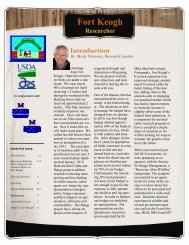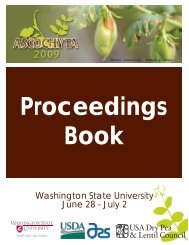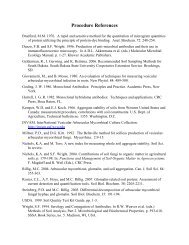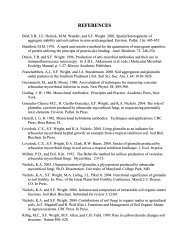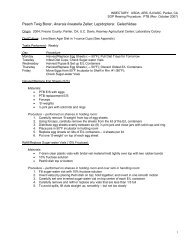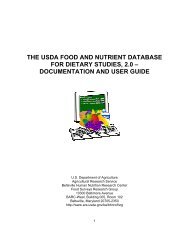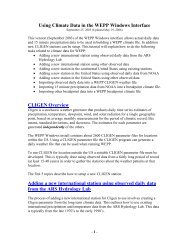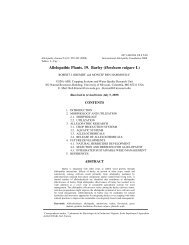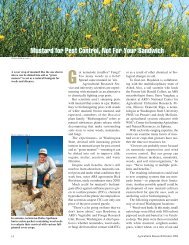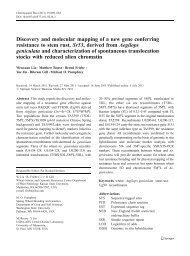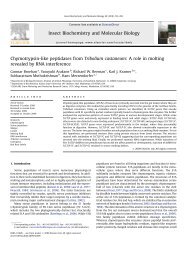INDICES TO - Agricultural Research Service - US Department of ...
INDICES TO - Agricultural Research Service - US Department of ...
INDICES TO - Agricultural Research Service - US Department of ...
Create successful ePaper yourself
Turn your PDF publications into a flip-book with our unique Google optimized e-Paper software.
Despite the short-term frustration <strong>of</strong> needing to deal with fungi belonging to these groups that the familiar<br />
concepts <strong>of</strong> Zygomycota, Zygomycotina and Zygomycetes are new abandoned. Until such a time as the molecular<br />
studies clarify the overall relationships among these fungi and establish a new set <strong>of</strong> phyla, my practical advice to<br />
the clientele <strong>of</strong> the ARSEF culture collection is to continue to use these discontinued phylum, subphylum and class<br />
names since (1) their meanings remain unambiguous in terms <strong>of</strong> the fungi included, and (2) journals and other<br />
outlets may remain unwilling or unable for some time still to handle the concepts <strong>of</strong> new subphyla with unassigned<br />
status (‘incertae sedis’).<br />
Entomopathogenic Ascomycetes and Associated Anamorphic (Conidial) States<br />
Among all <strong>of</strong> the major taxonomic changes within the fungi that affect entomopathogenic fungi, the most<br />
dramatic and far-reaching involve the ascomycetes and their conidial (anamorphic) states classified among the<br />
pyrenomycetous fungi <strong>of</strong> the order Hypocreales. In one <strong>of</strong> the first major changes to be noted, those ascomycetous<br />
entomopathogens whose asci are produced in perithecia (nearly closed spherical to flask-like fruiting bodies) are<br />
now put in the class Sordariomycetes, a name based on a valid generic name, rather than in the historically familiar<br />
class Pyrenomycetes, a name based on the morphology <strong>of</strong> the fruiting body. The great majority <strong>of</strong> these fungi<br />
have long been recognized to belong in the family Clavicipitaceae (mostly in the genera Cordyceps, Torrubiella or<br />
Hypocrella). A major phylogenetic reclassification <strong>of</strong> the Clavicipitaceae (Sung et al. 2007; available free <strong>of</strong> charge<br />
at http://www.studiesinmycology.org) has split this family into three (Table 1), a long overdue major reworking<br />
<strong>of</strong> the taxonomy <strong>of</strong> Cordyceps and, subsequently, a reshuffling <strong>of</strong> anamorphic states among these families. This<br />
publication by Sung et al. (2007) is very long and complex since it includes a highly detailed phylogenetic analysis<br />
<strong>of</strong> these fungi as well as presenting the new taxonomy, descriptions <strong>of</strong> new families, genera, and species, and a very<br />
large number <strong>of</strong> new combinations (mostly segregating Cordyceps into their newly described segregate genera),<br />
and listing <strong>of</strong> the known or suspected anamorphic states associated with these taxa.<br />
Note that Table 1 shows Torrubiella to be split between two families. This is an untenable position in a<br />
phylogenetically based classification that requires all taxa to represent monophyletic lineages. Future<br />
phylogenetic studies that will result in the reclassification <strong>of</strong> Torrubiella are obviously required. Also note that<br />
some anamorphic states with morphologies referable to Hirsutella, Paecilomyces and Verticillium (the latter<br />
two genera in their old senses from before recent phylogenetic reclassifications discussed below may occur in<br />
more than one family; this underscores the need to regard anamorphic states as being named in form-genera<br />
defined only by their morphologies and similar modes <strong>of</strong> development rather than by phylogenetic relatedness.<br />
Table 1. Summary <strong>of</strong> some major teleomorphic (sexual) and anamorphic (conidial) genera <strong>of</strong><br />
Hypocreales pathogenic to invertebrates (Sung et al. 2007).<br />
Clavicipitaceae<br />
FAMILY<br />
Cordycipitaceae Ophiocordycipitaceae<br />
Teleomorphs: Hypocrella, Metacordyceps, Cordyceps s.str., Ophiocordyceps,<br />
Regiocrella, Torrubiella Torrubiella Elaphocordyceps<br />
Anamorphs: Aschersonia, Metarhizium, Beauveria, Engyodontium, Haptocillium, Harposporium,<br />
Nomuraea, Paecilomyces-like 1 , Isaria, Lecanicillium, Hirsutella, Hymenostilbe,<br />
Pochonia, Rotiferophthora, Mariannaea-like, Paraisaria, Purpureocillium<br />
Verticillium-like 2 Microhilum, Simplicillium Sorosporella, Syngliocladium,<br />
Tolypocladium, Verticillium-like 2<br />
1 Species formerly in Paecilomyces sect. Isarioidea, now excluded from Paecilomyces in the strict sense but also<br />
from Isaria (which now includes most entomogenous species transferred from Paecilomyces).<br />
2 Species formerly in Verticillium sect. Prostrata, now excluded from Verticillium in the strict sense but not yet<br />
reclassified in the segregate genera recognized by Zare and Gams (see below).<br />
ii



